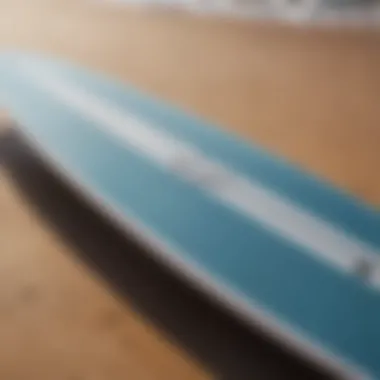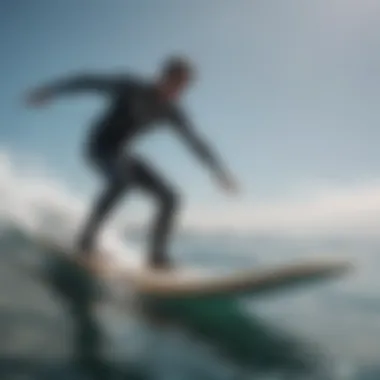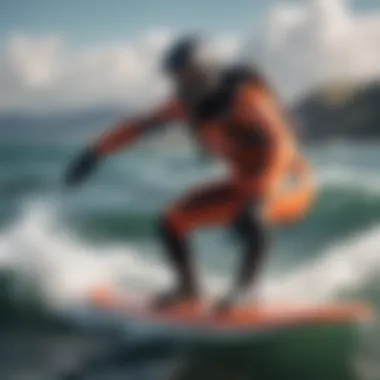Understanding Hydrofoil Surfboards: The Ultimate Guide


Preface
Hydrofoil surfboards represent a significant leap in the evolution of water sports, particularly kitesurfing. This guide seeks to detail this innovative technology, elucidating its construction, performance characteristics, and distinct riding experience. As enthusiasts of extreme sports seek new thrills, understanding hydrofoiling becomes indispensable. By integrating insights about their advantages and challenges, alongside necessary techniques and safety protocols, riders can maximize their experience with hydrofoil surfboards.
The hydrofoil design elevates surfers above the water's surface, reducing drag and enhancing speed. This section will introduce the structure of the hydrofoil itself, from wings to masts, and the varying styles prevalent on the market. Following this, we will delve into reviews of essential equipment, techniques for optimal usage, and crucial safety guidelines. This comprehensive exploration aims to benefit kitesurfers and kitesurfing aficionados seeking an informed perspective on a rapidly evolving sport.
Equipment Reviews
Kites
In today’s market, several kite models exist, each embodying unique features tailored for hydrofoil surfing. Understanding kite shapes—such as delta, C, and bow—is important. These options can significantly affect performance.
Kite sizes vary greatly. Smaller kites are faster and ideal for stronger winds, while larger kites provide better lift in lighter breezes. Materials used in kite construction influence durability and flexibility, with many brands utilizing ripstop nylon for total reliability.
Popular Kite Brands
Among popular brands, Naish, Cabrinha, and Duotone consistently deliver top-notch products, each catering to diverse rider preferences and skill levels.
Boards
When considering boards for kitesurfing with a hydrofoil, the choices span twintips and directional boards. Directional boards, often favored for their more agile designs, excel in surf-like conditions.
The construction of these boards matters significantly. High-density foam cores and carbon fiber layers are becoming standards for their lightness and strength. Preferred riding styles also dictate optimal board size and shape.
Accessories
Essential kiteboarding accessories cannot be overlooked. Harnesses ensure comfort and control, while appropriate lines and pumps are necessary for setup. In addition, safety gear like helmets and impact vests provides needed protection. The importance of each accessory often reflects a rider’s commitment to safety and performance.
Techniques and Tutorials
Beginner Guides
For new kitesurfers, solid foundational techniques are crucial. Learning the basics involves practicing how to launch and ride safely. Understanding how to control the kite and maneuver it effectively is step one.
Advanced Skills
As one gains experience, advanced skills come into play. Tricks, jumps, and wave riding each require additional focus and practice. Step-by-step tutorials can guide enthusiasts as they progress and refine their skills in hydrofoil surfing.
Safety Guidelines
Weather Conditions
Knowledge about weather conditions is paramount for safe kitesurfing. Factors like wind speed and water currents need monitoring. Adaptability is the key here, as conditions can change rapidly, impacting riding safety.
Emergency Protocols
Preparing for emergencies adds another layer of safety. Having clear plans and understanding rescue tactics for possible mishaps is essential. Familiarity with equipment, chemistry, and environment reduces risks.
Equipment Maintenance
Regular maintenance of equipment cannot be neglected. Completing periodic checks on kites, lines, and harnesses ensures performance and safety. It also minimizes accidents caused by equipment failure.
Understanding the critical nature of gear upkeep allows for better experiences on the water. Emphasizing minor details significantly boosts safety mobility.
The above discussion should assist readers in garnering a clearer grasp of hydrofoil surfboards. Following the outlined guidelines will enhance both enjoyment and safety out on the water.
Prelims to Hydrofoil Surfboards
Hydrofoil surfboards represent a significant innovation in the world of water sports, blending design with technology to create a unique riding experience. Understanding hydrofoil surfboards is not just about recognizing their mechanics but also about appreciating their impact on water sports. For enthusiasts, this introduction provides insight into a transformative method that challenges traditional surfing methods. The elegant structure and functionality of these boards significantly enhance performance for both kitesurfers and kiteboarders.


Definition and Overview
Hydrofoil surfboards feature a specialized design that incorporates a submerged wing-like structure known as a foil. This element is attached beneath the board, allowing it to rise above the water surface once sufficient speed is achieved. This revolutionizes the riding experience by particularly reducing drag and allowing for smoother glides. By lifting out of the water, these surfboards provide better stability, surf enthusiasts benefit from extended riding sessions without sacrificing performance. In essence, hydrofoil surfboarding combines the thrill of surfing with advanced engineering to open up new possibilities for rides in various water conditions.
History and Evolution
The beginnings of hydrofoil technology can be traced back to the 19th century with innovations like the hydrofoil ferry. However, the adaptation of this technology for recreational surfing took many years of development. Over the decades, with the emergence of various water sports, hydrofoils have evolved into a prominent segment of surfboarding. Innovations in materials and design, such as the utilization of lighter composites, have made these boards more accessible and easier to handle for riders of all skill levels. The recent surges in interest reflect a new trend within the surf community, driven by advancements in technology and a pursuit of enabling thrilling, high-speed experiences on the water.
The rise of hydrofoil surfboarding has categorized it as an elite choice among surf enthusiasts, focusing on enhancing speed, agility, and environmental adaptability.
In summation, understanding hydrofoil surfboards requires an appreciation of both forms and function. With their rich history and cutting-edge design, they stand as testaments to innovation in watersports.
Components of a Hydrofoil Surfboard
The components of a hydrofoil surfboard are fundamental to its performance, aiming to enhance the riding experience on water. Understanding these components is crucial for both beginners and experienced surfboard riders looking to optimize their skills. From design to materials, every element contributes significantly to how these surfboards operate under various conditions.
Board Design and Materials
The design of a hydrofoil surfboard is often distinct from traditional surfboards. Hydrofoil boards come in various shapes and sizes tailored for specific conditions and rider preferences.
Key Aspects of Board Design:
- Shape: Different shapes provide alternative buoyancy and stability, impacting the overall riding experience.
- Volume: This affects buoyancy; higher volume is suitable for beginners while lower volume may appeal to professionals for more advanced maneuvers.
Regarding materials, hydrofoil surfboards commonly use lightweight composites, such as epoxy or carbon fiber. These materials provide significant strength without adding excessive weight. This balance ensures improved agility and performance while riding.
Foil Structure: Wings and Masts
The foil structure, comprising the wings and mast, is essential for generating lift and improving performance. Understanding the elements involved in this structure allows riders to make informed choices about their gear.
Front Wing
The front wing is pivotal in determining how the hydrofoil surfboard lifts out of the water.
- A larger front wing increases lift but can create more drag.
- Ideal for beginners seeking stability as it facilitates early lift-off.
One notable characteristic of the front wing is its shape. Many wings have curved designs to enhance lift efficacy while maintaining control at various speeds. The main advantage is the ability to ride smoothly with less effort. But, a larger front wing may reduce maneuverability in some advanced riding scenarios.
Rear Wing
The rear wing serves a complementary but crucial role in controlling the pitch of the board, affecting its overall balance.
- Smaller rear wings typically allow for sharper turns.
- Larger rear wings enhance stability, thereby managing a smoother ride.
Its design encompasses aspects like aspect ratio and surface area. A bigger rear wing can facilitate greater stability but may limit quick directional changes. Thus, choosing the right design affects not only performance but also the learning curve for new riders.
Mast Height
Mast height directly influences the rider's experience on the water.
- Taller masts provide a higher ride, assisting in maintaining speed and avoiding obstacles beneath the surface.
- Shorter masts are preferable for beginners, allowing for easier handling in smaller surf conditions.
A critical aspect of mast height involves the level of maneuverability versus stability. While a taller mast can elevate the board, it requires precision management from the rider. Echelons on mast height range from 60 cm to over 90 cm, each offering unique benefits and challenges in usage.
Fin Setup and Compatibility
The fin setup is instrumental in achieving compatibility and stability for hydrofoil surfing. Adjustments to fin placements directly enhance the surfboard's handling, allowing for tailored riding experiences.
- Different fin configurations may affect drag and turning radius.
- Compatibility with various hydrofoil systems expands rider options significantly.


Understanding these components is vital as every part plays a role in ensuring that the hydrofoil surfboard effectively responds to the environment, balancing control, lift, and agility on the water.
How Hydrofoil Surfboards Work
The functionality of hydrofoil surfboards is central to their appeal among kitesurfing and extreme sports enthusiasts. Understanding how these innovative boards function opens up an entirely new dimension of sport performance. The three critical elements to consider are the principles of hydrodynamics, lift and drag factors, and riding mechanics. Each component plays a vital role in mastering the use of a hydrofoil surfboard.
Principles of Hydrodynamics
Hydrodynamics governs how hydrofoil surfboards interact with the water. Simplistically, the design of a hydrofoil permits it to move through the water in a way that reduces resistance, thereby enhancing efficiency.
- Buoyancy: When the hydrofoil is submerged, it produces buoyant forces that balance the weight of both the rider and the board. This buoyancy becomes crucial at higher speeds.
- Fluid Dynamics: The shape of the board interacts with water currents, generating the appropriate lift required for reducing drag. The curved profiles of the wings, once submerged, create a pressure difference above and below the foil that generates lift. Understanding these fluid dynamics principles allows riders to optimize speed and stability.
By mastering these principles, kitesurfers can better utilize their boards, maximizing performance with each ride.
Lift and Drag Factors
Lift and drag are paramount to understanding hydrofoil performance. These forces greatly affect how a rider experiences speed and control at sea.
- Lift: Generated as the foil moves through water, lift is essential for lifting the board above the surface. Increasing speed enhances lift until an optimum point is reached. Riders capitalize on this ability by subtly adjusting body posture.
- Drag: Drag opposes movement through water and can contribute to feeling sluggish or limited in speed. A well-optimized foil reduces drag through innovative design, allowing the board to glide smoothly.
When carefully balanced, lift and drag improve the rider's ability to cruise efficiently over various water conditions, making them crucial for performance metrics.
Riding Mechanics
Riding a hydrofoil surfboard involves coordination and precise movements to achieve balanced sailing. Key components to riding mechanics include:
- Balance Control: Riders must adjust their body weight to maintain an optimal center of gravity. Shifting weight slightly forward or backward alters lift, putting control in the rider's hands for smooth transitions.
- Kite Interaction: The rider’s connection to the kite adds another layer to riding dynamics. The tension from the kite should be maintained as it provides thrust and directional stability.
- Board Technique: Skillfully maneuvering the board requires an understanding of edge control and pressure management. The subtle movements of the rider impact how the foil interacts with the water surface.
Efficient riding mechanics can dramatically affect performance, making familiarity with these techniques essential for a rewarding hydrofoil surfing experience.
Mastering the mechanics of hydrofoil surfing allows individuals to experience the water in an entirely new way, transforming standard surf sessions into an adventurous pursuit of control and speed.
Advantages of Hydrofoil Surfboarding
The advantages of hydrofoil surfboarding play a critical role in its growing appeal among surfers and kitesurfers alike. This innovative surfing approach presents distinct benefits that enhance performance on the water, expand maneuverability, and support environmentally conscious riding. Understanding these advantages can foster better appreciation for sustaing engagement in the sport and can influence purchasing decisions for new athletes as well.
Improved Performance in Various Conditions
Hydrofoil surfboards excel in a variety of water conditions where conventional boards may struggle. The key lies in the hydrofoil's unique design, which raises the board above the water. This elevation reduces resistance and allows for improved speed. Moreover, hydrofoils can generate lift even in smaller waves, enabling surfers to maintain momentum where traditionally, they may have stopped paddling.
Surfers can navigate choppy waters with more control compared to standard surfboards. The splashes and surface movements normally troublesome in typical surfing setups pose less of a challenge to hydrofoils. More importantly, hydrofoil boards also allow for progression through less favorable wind conditions, thus enhancing the potential for thrills regardless of environmental elements.
Enhanced Maneuverability
Hydrofoil surfboards provide exceptional maneuverability during rides, which contributes to a more dynamic experience. While flying above the water, surfers gain a fresh perspective and agility that isn’t available on traditional surfboards. Subtle weight shifts translate into swift turns and rapid adjustments, providing creative freedom to experts and enthusiasts alike.
The nature of hydrodynamic lift also helps achieve sharper angles and sustained speeds, which further redraws the possibilities for tricks and maneuvers. Foil surfers often find it easier to execute radical moves mid-air. Success in mastering these developments naturally propels riders into skill refinement and mountable stages of upper-level surfing.
Eco-Friendly Surfing Experience
Hydrofoil surfing is comparatively kinder to the environment. Traditional surf sports often require heavier equipment and generate increased mechanical reliance. Hydrofoil setups, conversely, offer lighter, simpler, and more effective surfing experiences. The underlying premise is predicated on gliding smoothly without crushing wave dignity, granting riders the ability to traverse waters while minimizing ecological disturbance.
As interest grows regarding sustainability, hydrofoils present another layer of awareness toward environmentally-friendly practices in watersports. Encouraging practices including proper disposal of equipment, focused riding in untouched waters, and promoting conservation effort may ultimately align hydrofoil surfing with maintaining natural beauty on oceans.
Hydrofoil surfboarding blends thrill and adaptability with a commitment to eco-conscious enjoyment. Experiences become exciting and intense, while still maintaining respect for the marine environment.
Equipment integrity heavily influences both performance and rider safety.
Ignoring safety measures can not only increase risk on the water but also lead to significant equipment loss, causing tension in rider patience and attaching unnecessary expense within such a progressive sport.


Ultimately, addressing these challenges will help kitesurfers enjoy hydrofoil surfing. Aiming for balanced learning, emphasizing routine maintenance, and mechanisms around safety will transition barriers into enjoyable, achievement-laden experiences on the water.
Techniques for Riding Hydrofoil Surfboards
The proficiency in riding hydrofoil surfboards can vastly enhance a user’s experience on the water. This segment aims to delve into the specific techniques that riders can utilize, resulting in better performance and enjoyment while hydrofoiling. Understanding these techniques allows enthusiasts not only to appreciate their boards but also to push their limits with safety as a priority. The following sections explore basic techniques for beginners and advanced maneuvers crafted for seasoned riders.
Getting Started: Basic Techniques
Before launching into complex tricks, it is important to grasp essential techniques that lay a foundation for successful hydrofoil riding.
- Proper Stance: Align your body at the board’s center. Maintain a comfortable, slightly bent leg position. This posture ensures steadiness and balance, crucial in keeping control of the lift.
- Starting Slow: It’s natural for hydrofoiling to intimidate. Aside from other watersports, this activity needs smoother, more gradual movements. Beginners should find flat, calm waters and start with low speeds. This environment allows for minimizing risk while gaining familiarity with lift and drag.
- Rider Focus: As you begin, focus on your upper body balance. Keep your core engaged while flowing weight shifts through your legs. Any movement should be controlled. Your use of limbs should solely be for minor adjustments.
The shift from surface riding to the moment of lift can be exhilarating, yet maintaining calm and understanding your board's response to movements keeps it safe and enjoyable. Remember to frequently adjust your kite angle as you progress, maintaining flow with your movements.
Advanced Techniques: Tricks and Maneuvers
For riders looking to elevate their game, advancing toward more complex tricks can be both thrilling and rewarding. Mastery of the following maneuvers reflects significant skills, not merely of hydrofolie riding but also of water dynamics:
- Jumping: Propel yourself off the water. Proper leg compression and weight distribution allow for flight over waves. Use the entirety of your lift to smoothly land back on the surface with minimal impact.
- Carving Turns: Utilize the hydrodynamic shape of the foil for memorable carving experiences. As your board rotates underneath you, balance your weight accordingly to keep from sinking. Gently leaning laterally does the job swiftly without sacrificing control.
- Ride Direction Changes: Adjusting from heel-to-toe edge positioning permits dynamic changes in directions instantaneously. The execution requires quick reflexes, precisely planning how much surface area engages with the water during transitions to stay afloat. Those movements ignite surety in completed turns, proving stability as you complete drastic course changes.
Mastering these advanced techniques transforms every session into a challenge that pushes your skills.
Ultimately, honing these skills rewards riders with a mixture of freedom, precision, and introspection with the craft. Those curious about continuing the quest toward mastery can generally chia practice substantially and foster an impressive level of waterside skill.
Riders must remain mindful of obstacles and conditions, emphasizing the significant respect required for safety while embracing challenges and seeking innovative flows after each progression.
Safety Guidelines for Hydrofoil Surfboarding
Safety is paramount when engaging in any water sport, and hydrofoil surfboarding is no exception. Understanding appropriate safety guidelines helps to protect not only the rider but also those around them. It merges preparation with precaution, ensuring a more enjoyable experience when flying above the water on a foil. Recognizing the specific conditions and challenges unique to hydrofoil surfing leads to better safety practices.
Protective Gear Recommendations
To mitigate risks while hydrofoiling, the use of protective gear is essential. This gear contributes to overall safety and can assist in injury prevention during falls or unexpected collisions. Recommended protective items include:
- Helmet: A properly fitted helmet can protect the rider's head during falls. There are specialized water sports helmets designed for impact resistance in the surf environment.
- Impact Vest: An impact vest provides floatation and damps the shock from any contact with water or objects. For additional safety, consider vests that are also built to offer insulation.
- Wetsuit: Wearing a wetsuit serves multiple purposes. It protects against cold conditions and cuts that could occur from sharp edges common in hydrofoil equipment.
- Footstraps and Pads: Footstraps help secure the rider's positioning on the board, preventing sudden disconnections after a fall. Good grips also support stability when in the water.
In short, making thoughtful choices concerning protective gear ensures that the ride remains fun but secure.
Environment-Specific Safety Considerations
The water environment plays a crucial role in safe hydrofoil surfing. Surfboarders should consider both environmental factors and local conditions prior to launching their boards. Here are essential considerations:
- Water Depth: Always evaluate the water depth before launching. Too shallow waters can increase the risk of injury from sudden stops on a hard surface.
- Weather Conditions: Pay close attention to weather conditions such as wind speed and direction, as these can greatly affect control and stability on the water. Ideal conditions should not exceed safe thresholds for responsible surfing.
- Crowded Beaches: When kitesurfing in crowded areas, ensure there is abundant space and avoid areas swarming with other surfers, swimmers, or obstacles. Collisions can pose serious hazards.
- Marine Life Awareness: Understanding local marine life is vital. Always be aware of zones where encounters with sharks or jellyfish could occur to avoid unsafe situations.
Hydrofoil surfboarding can offer a thrilling experience, but safety should always precede excitement. Being well-prepared is key.
Implementing these recommendations is vital to ensure a safe and enjoyable experience on a hydrofoil surfboard. Providing due consideration to the environment coupled with proper gear leads to maximized safety. Investing time in understanding the surf conditions can elevate the entire hydrofoil experience.
End and Future Trends in Hydrofoiling
Hydrofoil surfboards are carving a unique niche in the water sports domain. As we analyze the current landscape of hydrofoiling, it is imperative to reflect on two key elements: contributions of innovations in hydrofoil technology and the various factors driving community engagement. Together, these components not only enhance our understanding of hydrofoils but also provide insights for prospective enthusiasts.
Innovations in Hydrofoil Technology
Recent years have seen significant advancements in hydrofoil technology. Manufacturers continue to refine materials such as carbon fiber, leading to lighter and stronger boards. These improvements not only enhance performance but also reduce maintenance needs. Besides material upgrades, the design of the fuselage and wings is evolving. Hydrofoil wings, for instance, now include various profiles which improve lift efficiency and offer better maneuverability.
The integration of smart technology is another defining feature. For example, products like the Lift Foils allow for real-time performance monitoring. These innovations make learning and mastering hydrofoil surfboarding easier for enthusiasts.
Ultimately, evolutions in hydrofoil technology emphasize lightness, efficiency, and user experience.
Growing Popularity and Community Engagement
The popularity of hydrofoil surfboards is seemingly expanding rapidly. Factors contributing to this trend include entertaining YouTube videos and strong social media presence. Platforms such as Instagram and Reddit showcase exciting hydrofoiling sessions, inspiring thousands to interest into this innovative sport. Community engagement plays a critical role in promoting hydrofoiling culture.
Local surf shops and online forums consistently provide platforms for exchanging ideas, skills, and troubleshooting common issues experienced by riders. By participating in community events and sharing content, enthusiasts can experience a sense of belonging.
The combination of technological advancements and active community engagement points towards an exciting future for hydrofoil surfboards, making them an essential subject within water sports discussions.







